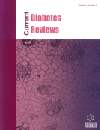- Home
- A-Z Publications
- Current Diabetes Reviews
- Previous Issues
- Volume 16, Issue 1, 2020
Current Diabetes Reviews - Volume 16, Issue 1, 2020
Volume 16, Issue 1, 2020
-
-
Lignans' Potential in Pre and Post-onset Type 2 Diabetes Management
More LessAuthors: Douglas E. Barre and Kazimiera Amella Mizier-BarreIntroduction: Type 2 Diabetes (T2D) cases continue to rise dramatically despite efforts to get people to exercise and eat with a view to health and combatting the cluster of 7 issues (central obesity (elevated waist circumference), hyperglycaemia, hypertension, dyslipidemia, pro-thrombotic state, increased oxidation (including Low-density Lipoprotein (LDL)) and the pro-inflammatory state associated with pre- and post-onset Read More
-
-
-
Nutraceuticals and Diet-based Phytochemicals in Type 2 Diabetes Mellitus: From Whole Food to Components with Defined Roles and Mechanisms
More LessAuthors: Adejoke Y. Onaolapo and Olakunle James OnaolapoBackground: Over the past decades, the development and use of an array of prescription medications have considerably improved the clinical management of type 2 diabetes mellitus and the quality of life of patients. However, as our knowledge of the associated risk factors and approaches to its management increases, the increasing roles of diet and the composition of the diet in the etiology and successful man Read More
-
-
-
Streptozotocin-Induced Diabetes Mellitus in Neonatal Rats: An Insight into its Applications to Induce Diabetic Complications
More LessAuthors: Mirza A. Baig and Shital Sharad PanchalBackground: Diabetic complications are the major contributor in the mortality of diabetic patients despite controlling blood glucose level. In the journey of new drug discovery, animal models have to play a major role. A large number of chemical-induced and genetically modified animal models have been investigated to induce diabetic complications but none of them was found to be mimicking the pathophysiology of the Read More
-
-
-
ADIE - Nursing Interventions of Diabetic Foot Ulcer: An Integrative Review of the Literature
More LessBackground and Aims: Diabetic foot ulcer is recognized as a consequence of peripheral neuropathy and peripheral arterial disease amid individuals with diabetes. As is well known, this situation still remains a crucial problem in nursing practice. Available studies describing an algorithm of inter- related nursing interventions concerned with diabetic foot ulcers are limited. Therefore, this integrative review was aimed to present evi Read More
-
-
-
A Review of Type 2 Diabetes Mellitus Predisposing Genes
More LessAuthors: Tajudeen O. Yahaya and Titilola F. SalisuIntroduction: Scientists are considering the possibility of treating diabetes mellitus (DM) using a personalized approach in which various forms of the diseases will be treated based on the causal gene and its pathogenesis. To this end, scientists have identified mutations in certain genes as probable causes of Type 2 diabetes mellitus (T2DM) with diverse mechanisms. Aim: This review was aimed at articulating already identified T2DM Read More
-
-
-
Charcot Neuroarthropathy: From the Laboratory to the Bedside
More LessBackground: The diabetic Charcot foot syndrome is a serious and potentially limbthreatening lower-extremity complication of diabetes. Introduction: The present review provides a concise account of the advances made over the last twentyfive years in understanding the pathogenesis and management of Charcot neuroarthropathy (CN). Methods: In this study, the widely known pathogenetic mechanisms u Read More
-
-
-
Role of C1858T Polymorphism of Lymphoid Tyrosine Phosphatase in Egyptian Children and Adolescents with Type 1 Diabetes
More LessBackground: Type 1 Diabetes Mellitus (T1DM) is a multifactorial autoimmune disease. The Protein Tyrosine Phosphatase Non-receptor 22 (PTPN22) gene is an important negative regulator of signal transduction through the T-cell Receptors (TCR). A PTPN22 polymorphism, C1858T, has been found to be a risk determinant for several autoimmune diseases, including T1DM, in different populations. Objective: The present study Read More
-
-
-
For Physical Laborers with Type 2 Diabetes, Telephonic Health Coaching is not Enough to Improve A1C
More LessBy Mike SwobodaObjectives: Telephonic health coaching has been studied extensively as an interventional approach for chronic disease management. No studies have been conducted evaluating the outcomes of a multiyear study on health coaching participation and glycated haemoglobin (A1C) changes. Chronic disease has been widespread in physical laborers, with a high onset of type 2 diabetes. The purpose of this study was to establis Read More
-
-
-
Intron-specific Single Nucleotide Polymorphisms of Fat Mass and Obesity-Associated Gene in Obese and Overweight Individuals of the Indian Adult Population- A Pilot Study
More LessBackground: The Fat mass and obesity-associated gene (FTO) and its involvement in weight gain and obesity is well-known. However, no reports have been published on the Indian population regarding the relationship between single nucleotide polymorphisms (SNPs) in its intronic region and obesity. The aim of this pilot study was to evaluate the frequency and association of SNPs in intron-1 of the FTO gene in obese and over Read More
-
Volumes & issues
-
Volume 21 (2025)
-
Volume 20 (2024)
-
Volume 19 (2023)
-
Volume 18 (2022)
-
Volume 17 (2021)
-
Volume 16 (2020)
-
Volume 15 (2019)
-
Volume 14 (2018)
-
Volume 13 (2017)
-
Volume 12 (2016)
-
Volume 11 (2015)
-
Volume 10 (2014)
-
Volume 9 (2013)
-
Volume 8 (2012)
-
Volume 7 (2011)
-
Volume 6 (2010)
-
Volume 5 (2009)
-
Volume 4 (2008)
-
Volume 3 (2007)
-
Volume 2 (2006)
-
Volume 1 (2005)
Most Read This Month
Article
content/journals/cdr
Journal
10
5
false
en


